Water-Based Aerosol for Book Deacidification: Experimental Apparatus and Theoretical Interpretation of Results
Abstract
:1. Introduction
- The “Sablè” method is a French variation of the Wei T’o system invented by Richard D. Smith and developed by the National Archive in Canada. It was adopted between 1987 and 1989. The system consists of the insertion of open volumes, kept in a vertical position inside metal baskets, into an autoclave. The volumes are first dried at 45 °C and then impregnated for 10 min with a mixture consisting of ethoxy-magnesium carbonate and ethanol [21,22];
- The Bookkeeper® method, devised in 1985, is based on the use of magnesium oxide microparticles dispersed in perfluoroheptane and the addition of a surfactant. The volumes are placed on vertical supports and opened at an angle of 90° and then placed inside four reactors that operate sequentially and can treat 32 volumes in 2 h. The deacidifying product is inserted, after establishing vacuum conditions. This is one of the most popular methods for its speed of execution and relatively low costs. The Bookkeeper® method provides a considerable reduction of paper degradation and does not affect inks and book ligatures. However, it is reported in the literature that this method appears less efficient for the treatment of large-sized books due to the fact that the alkaline reserve is low and the deacidification is not very uniform. The solvent seems to have a low penetration capacity into the paper fibers, and some white patina appears on the surface [2,21,23,24];
- The “ZFB:2” method, devised in 2011, uses calcium carbonate and magnesium oxide dispersed in heptane. The volumes are not opened, and the process takes about four weeks [26];
- The “Papersave” method from Battelle Ingenieurtechnik GmbH and the “Papersave Swiss” method use magnesium and titanium ethyloxides dissolved in hexa-dimethyl siloxane and provide good penetration and an alkaline reserve, reducing the degradation of cellulose with aging. However, the treatment cannot be applied to leather covers, pergamene covers, patinated papers and newspapers. Inconvenient decreases in paper mechanical strength, discoloration, white deposits and ink bleeding have been observed [27].
2. Materials and Methods
2.1. Aerosol System
- The book “Studi di Enologia” del cav. Angelo Mona (Brescia—Pio Istituto Pavoni—1875), the title page of which is shown in Figure 4, after being weighed, was supported on the holder, as indicated in Figure 2b, and inserted into the flask. At the actual development stage of our homemade apparatus, only a limited number of pages could be homogeneously treated with the alkaline droplets. For this reason, only 12 (from 1 to 6 and from 91 to 96 pages) of the almost 200 pages of the book were kept wide open to facilitate a uniform deposition of the aerosol through a single nozzle. The other pages were kept firmly closed in order to exclude them from the deacidification process;
- The book, placed into the flask, was exposed to a dry air flux at the temperature of 45 °C for 15 min. Then, it was extracted from the chamber and weighed. The weight variation was 3.45%;
- The book was replaced in the chamber. A cloud of nebulized solution was fluxed above the open pages through the nozzle placed on the top hemisphere. The aerosol inlet was left to flow for 3 min, while the valve on the bottom of the flask was kept open to ensure a constant pressure in the flask;
- The book was removed from the flask and weighed in order to measure the amount of the absorbed basic solution and inserted back into the treatment chamber;
- Dry air at the temperature of 45 °C was let gently fluxed into the flask for 3 min, entering with the help of a small pressure gradient (around 0.05 atm) and exiting through the bottom open valve. The rehydration of the air gradually removed the absorbed humidity from the book. After the above dehydration cycle, the book was weighed. This step was repeated 5 times in order to bring the book to a constant weight;
- The pH on every treated page was measured in six different points, as described in Section 2.4, and the average value was recorded;
- The procedure described above, as defined in Steps 3 to 6, was repeated 8 times in order to reach a satisfactory pH value.
2.2. X-ray Fluorescence (XRF)
2.3. FTIR Spectroscopy
2.4. Powder X-ray Diffraction (PXRD)
2.5. Contact pH Meter
2.6. Artificial Aging
2.7. Colorimetry and Optical Microscopy
2.8. Determination of the Degree of Polymerization (DP)
2.9. Alkaline Reserve Determination
3. Results and Discussion
3.1. FTIR Results
3.2. PXRD Results
3.3. X-ray Fluorescence Results
3.4. pH Results
- A 40 μL volume of water droplets is dispersed on the paper to measure the pH, and droplets diffuse on the surface corresponding to the measure electrode surface (0.78 cm2);
- The total surface of the opened pages, hypothesized to be the only absorbers of the nebulized solution, is equal to 1560 cm2;
- The concentration of the Ca2+ ion in the nebulized solution is equal to 8.73 × 10−3. Simple calculations made on the assumption that the added calcium hydroxide dissolves completely in the water droplet dispersed under the pH measure electrode would lead to a theoretical value of the β factor equal to about 10−4; that is to say, a value one order of degree bigger with respect to that furnished by the fit of the titration curve. This apparent discrepancy can be explained, in our opinion, considering that a greater part of the added calcium hydroxide can react with the atmospheric CO2, during the drying stage of the paper, becoming calcium carbonate, which remains in the system as an alkaline reserve. On the basis of this hypothesis, the values of β could justify a contribution to the alkaline reserve of the order of about 0.15% of calcium carbonate with respect to the weight of the paper.
3.5. Colorimetric and Optical Microscopic Analysis Results
3.6. Cellulose Degree of Polymerization
3.7. Alkaline Reserve Results
4. Conclusions
Author Contributions
Funding
Institutional Review Board Statement
Informed Consent Statement
Data Availability Statement
Conflicts of Interest
Sample Availability
References
- Sequeira, S.; Casanova, C.; Cabrita, E.J. Deacidification of paper using dispersions of Ca(OH)2 nanoparticles in isopropanol. Study of efficiency. J. Cult. Herit. 2006, 7, 264–272. [Google Scholar] [CrossRef]
- Hubbe, M.A.; Smith, R.D.; Zou, X.; Katuscak, S.; Potthast, A.; Ahn, K. Deacidification of Acidic Books and Paper by Means of Non-aqueous Dispersions of Alkaline Particles: A Review Focusing on Completeness of the Reaction. BioResources 2017, 12, 4410–4477. [Google Scholar] [CrossRef] [Green Version]
- Whitmore, P.M.; Bogaard, J. Determination of the Cellulose Scission Route in the Hydrolytic and Oxidative Degradation of Paper. Restaurator 1994, 15, 26–45. [Google Scholar] [CrossRef]
- Cunha, G.M. Mass deacidification for libraries. Libr. Technol. Rep. 1987, 23, 361–472. [Google Scholar]
- Smith, R.D. Deacidifying Library Collections: Myths and Realities. Restaurator 1987, 8, 69–93. [Google Scholar] [CrossRef]
- Baty, J.W.; Maitland, C.L.; Minter, W.; Hubbe, M.A.; Jordan-Mowery, S.K. Deacidification for the conservation and preserva-tion of paper-based works: A review. BioResources 2010, 5, 1955–2023. [Google Scholar] [CrossRef]
- Tursi, A. A Review on Biomass: Importance, Chemistry, Classification, and Conversion. Biofuel Res. J. 2019, 22, 962–979. [Google Scholar] [CrossRef]
- Daniels, V.D. The chemistry of paper conservation. Chem. Soc. Rev. 1996, 25, 179–186. [Google Scholar] [CrossRef]
- Kačík, F.; Kačíková, D.; Jablonský, M.; Katuščák, S. Cellulose degradation in newsprint paper ageing. Polym. Degrad. Stab. 2009, 94, 1509–1514. [Google Scholar] [CrossRef]
- Shahani, C.J.; Harrison, G. Spontaneous Formation of Acids in The Natural Aging of Paper. Stud. Conserv. 2002, 47, 189–192. [Google Scholar] [CrossRef]
- Zervos, S. Natural and accelerated ageing of cellulose and paper: A literature review. In Cellulose: Structure and Properties, Derivatives and Industrial Uses; Lejeune, A., Deprez, T., Eds.; Nova Publishing: New York, NY, USA, 2010; pp. 155–203. [Google Scholar]
- Zervos, S.; Moropoulou, A. Cotton Cellulose Ageing in Sealed Vessels. Kinetic Model of Autocatalytic Depolymerization. Cellulose 2005, 12, 485–496. [Google Scholar] [CrossRef]
- French, A.D. Glucose, not cellobiose, is the repeating unit of cellulose and why that is important. Cellulose 2017, 24, 4605–4609. [Google Scholar] [CrossRef]
- Romeo, I.; Olivito, F.; Tursi, A.; Algieri, V.; Beneduci, A.; Chidichimo, G.; Maiuolo, L.; Sicilia, E.; De Nino, A. Totally green cellulose conversion into bio-oil and cellulose citrate using molten citric acid in an open system: Synthesis, characterization and computational investigation of reaction mechanisms. RSC Adv. 2020, 10, 34738–34751. [Google Scholar] [CrossRef]
- Margutti, S.; Conio, G.; Calvini, P.; Pedemonte, E. Hydrolytic and Oxidative Degradation of Paper. Restaurator 2001, 22, 67–83. [Google Scholar] [CrossRef]
- Lienardy, A. Evaluation of Seven Mass Deacidification Treatments. Restaurator 1994, 15, 1–25. [Google Scholar] [CrossRef]
- Cedzová, M.; Gállová, I.; Katuščák, S.; Katuščák, M.C.I.G.S. Patents for Paper Deacidification. Restaurator 2006, 27, 35–45. [Google Scholar] [CrossRef]
- Stefanis, E.; Panayiotou, C. Protection of Lignocellulosic and Cellulosic Paper by Deacidification with Dispersions of Micro- and Nano-particles of Ca(OH)2 and Mg(OH)2 in Alcohols. Restaurator 2007, 28, 185–200. [Google Scholar] [CrossRef]
- Bredereck, K.; Haberditzl, A.; Bluher, A. Paper deacidification in large workshops: Effectiveness and practicability. Restaurator 1990, 11, 165–178. [Google Scholar] [CrossRef]
- Brückle, I.; Dambrogio, J. Paper splitting: History and modern technology. J. Am. Inst. Conservat. 2000, 39, 295–325. [Google Scholar] [CrossRef]
- Buisson, N. La désacidification de masse rappel historique et technique. L’offre actuelle: Une technique en expansion dans le monde. Actual. Conserv. 2011, 31, 1–15. [Google Scholar]
- Lefebvre, A. Une technique encore peu répandue en France: Historique et pratique actuelle de la désacidification à la Biblio-thèque nationale de France. Actual. Conserv. 2012, 31, 1–4. [Google Scholar]
- Buchanan, S. An Evaluation of the Bookkeeper Mass Deacidification Process. In Library of Congress; Library of Congress Preservation Directorate: Washington, DC, USA, 1994. [Google Scholar]
- Stephens, C.H.; Barrett, T.; Whitmore, P.M.; Wade, J.A.; Mazurek, J.; Schilling, M. Composition and Condition of Naturally Aged Papers. J. Am. Inst. Conserv. 2008, 47, 201–215. [Google Scholar] [CrossRef]
- Hubbe, M.; Henniges, U.; Potthast, A.; Ahn, K.; Smith, R. Nonaqueous solution deacidification treatments to prolong the storage life of acidic books: A review of mechanistic and process aspects. BioResources 2018, 13, 7096–7136. [Google Scholar] [CrossRef]
- Potthast, A.; Ahn, K. Critical evaluation of approaches toward mass deacidification of paper by dispersed particles. Cellulose 2017, 24, 323–332. [Google Scholar] [CrossRef] [Green Version]
- Andres, H.; Blüher, A.; Grossenbacher, G.; Reist, M.; Vogelsanger, B.; Wälchli, M. The Papersave Swiss-Process Quality Control and Efficacy. Restaurator 2008, 29, 3–28. [Google Scholar] [CrossRef]
- Giorgi, R.; Dei, L.; Ceccato, M.; Schettino, C.; Baglioni, P. Nanotechnologies for Conservation of Cultural Heritage: Paper and Canvas Deacidification. Langmuir 2002, 18, 8198–8203. [Google Scholar] [CrossRef]
- Cheradame, H.; Ipert, S.; Rousset, E. Mass Deacidification of Paper and Books. I: Study of the Limitations of the Gas Phase Processes. Restaurator 2003, 24, 227–239. [Google Scholar] [CrossRef]
- Jablonsky, M.; Holubkova, S.; Kazikova, J.; Botkova, M.; Haz, A.; Bajzikova, M. The treatment of acid newsprint paper: Evaluation of treatment by MgO or by a mixture of MgO and methyl methoxy magnesium carbonate. Wood Res. 2013, 58, 151–164. [Google Scholar]
- Ramin, M.; Andres, H.; Blüher, A.; Reist, M.; Wälchli, M. Paper de-acidification—A comparative study. J. Pap. Conserv. 2009, 10, 17–25. [Google Scholar]
- Stauderman, S.D.; Brückle, I.; Bischoff, J.J. Observations on the Use of Bookkeeper® Deacidification Spray for the Treatment of Individual Objects; The American Institute for Conservation: Washington, DC, USA, 1996; Volume 15, Available online: http://cool.conservation-us.org/coolaic/sg/bpg/annual/v15/bp15–17.html (accessed on 13 July 2016).
- Reissland, B. Ink Corrosion. Aqueous and Non-Aqueous Treatment of Paper Objects-State of the Art. Restaurator 1999, 20, 167–180. [Google Scholar] [CrossRef]
- Smith, A.W. Aqueous deacidification of paper. In Paper and Water: A Guide for Conservators; Banik, G., Bruckle, I., Eds.; Elsevier: Amsterdam, The Netherlands; Butterworth-Heinemann: Oxford, UK, 2011; pp. 341–388. [Google Scholar]
- Ambrosi, M.; Dei, L.; Giorgi, R.; Neto, C.; Baglioni, P. Colloidal Particles of Ca(OH)2: Properties and Applications to Restoration of Frescoes. Langmuir 2001, 17, 4251–4255. [Google Scholar] [CrossRef]
- Chen, J.; Fan, H.; Gan, Q.; Gao, D.; Guo, M.; Li, J.; Wang, H. Novel Ancient Book Deacidification Consolidate Reinforcing Device. Patent No. CN207608770U, 13 July 2018. [Google Scholar]
- Chen, J.; Fan, H.; Gan, Q.; Gao, D.; Guo, M.; Li, J.; Wang, H. New Type of Ancient-Book Deacidification and Reinforcing and Strengthening Apparatus. Patent No. WO2019105489A1, 6 June 2019. [Google Scholar]
- Fan, H.; Guo, M.; Li, J.; Liu, J.; Liu, Q.; Xie, K. A Deacidification Strengthening Device for Whole Sets of Ancient Books in Batch. Patent No. CN108914701, 30 November 2018. [Google Scholar]
- Fan, H.; Guo, M.; Li, J.; Liu, J.; Liu, Q.; Xie, K. Deacidification Reinforcing Device Capable of Being Used for Whole Ancient Books in Batches. Patent No. CN208857593U, 14 May 2019. [Google Scholar]
- Chen, J.; Fan, H.; Gan, Q.; Gao, D.; Guo, M.; Li, J.; Wang, H. Novel Method for Repairing Ancient Book by Deacidification. Patent No. WO2019105168A1, 6 June 2019. [Google Scholar]
- Kratzert, A.; Leisch, N.; Zitzmann, P. Process and Apparatus for Deacidifying Books. Patent No. EP1283300A2, 12 December 2003. [Google Scholar]
- TAPPI. Surface pH Measurement of Paper, TAPPI T529 om-99; 2002–2003 TAPPI Test Method; TAPPI Press: Atlanta, GA, USA, 2002. [Google Scholar]
- Bégin, P.L.; Kaminska, E. Thermal Accelerated Ageing Test Method Development. Restaurator 2002, 23, 89–105. [Google Scholar] [CrossRef]
- Brainard, D.H. Color Appearance and Color Difference Specification. In The Science of Color; Shevell, S., Ed.; Elsevier Science: London, UK, 2003; pp. 191–216. [Google Scholar]
- Gooch, J.W. Whiteness Index. In Encyclopedic Dictionary of Polymers; Gooch, J.W., Ed.; Springer: New York, NY, USA, 2011; p. 811. [Google Scholar]
- UNI. UNI 8282 Cellulose in Dilute Solutions—Determination of Limiting Viscosity Number—Method in Cupri-Ethylene-Diamine (CED) Solution—Equivalent to the ISO Standard 5351/1; Italian National Unification Body (UNI): Milano, Italy, 1994. [Google Scholar]
- TAPPI. Alkalinity of Papers Calcium Carbonate (Alkaline Reserve of Paper), TAPPI T533 pm-92; 2002–2003 TAPPI Test Method; TAPPI Press: Atlanta, GA, USA, 2002. [Google Scholar]
- Garside, P.; Wyeth, P. Identification of Cellulosic Fibres by FTIR Spectroscopy-Thread and Single Fibre Analysis by Attenuated Total Reflectance. Stud. Conserv. 2003, 48, 269–275. [Google Scholar] [CrossRef] [Green Version]
- Librando, V.; Minniti, Z.; Lorusso, S. Ancient and Modern Paper Characterization by FTIR and Micro-Raman Spectroscopy. Conserv. Sci. Cult. Herit. 2011, 11, 249–268. [Google Scholar]
- Hospodarova, V.; Singovszka, E.; Stevulova, N. Characterization of Cellulosic Fibers by FTIR Spectroscopy for Their Further Implementation to Building Materials. Am. J. Anal. Chem. 2018, 9, 303–310. [Google Scholar] [CrossRef] [Green Version]
- Miller, F.A.; Wilkins, C.H. Infrared Spectra and Characteristic Frequencies of Inorganic Ions. Anal. Chem. 1952, 24, 1253–1294. [Google Scholar] [CrossRef]
- French, A.D. Idealized powder diffraction patterns for cellulose polymorphs. Cellulose 2013, 21, 885–896. [Google Scholar] [CrossRef]
- Strazdins, E. Theoretical and practical aspects of alum use in papermaking. Nord. Pulp Pap. Res. J. 1989, 4, 128–134. [Google Scholar] [CrossRef]
- Hubbe, M.A.; Bowden, C. Handmade paper: A review of its history, craft, and science. BioResources 2009, 4, 1736–1792. [Google Scholar] [CrossRef]
- Liu, Y.; Naidu, R. Hidden values in bauxite residue (red mud): Recovery of metals. Waste Manag. 2014, 34, 2662–2673. [Google Scholar] [CrossRef] [PubMed]
- Flynn, C.M. Hydrolysis of inorganic iron(III) salts. Chem. Rev. 1984, 84, 31–41. [Google Scholar] [CrossRef]
- Sarpola, A. The Hydrolysis of Aluminium, a Mass Spectrometric Study. Ph.D. Thesis, University of Oulu, Oulu, Finland, 2007. [Google Scholar]
- Snoeyink, V.L.; Jenkins, D. Water Chemistry; Wiley and Sons: New York, NY, USA, 1980. [Google Scholar]
- Conte, A.M.; Pulci, O.; Knapik, A.; Bagniuk, J.; Del Sole, R.; Lojewska, J.; Missori, M. Role of cellulose oxidation in the yellowing of ancient paper. Phys. Rev. Lett. 2012, 108, 158301. [Google Scholar] [CrossRef] [PubMed]
- Ahn, K.; Henniges, U.; Blüher, A.; Banik, G.; Potthast, A. Sustainability of Mass Deacidification. Part I: Concept, Selection of Sample Books and pH-Determination. Restaurator 2011, 32, 48–75. [Google Scholar] [CrossRef]

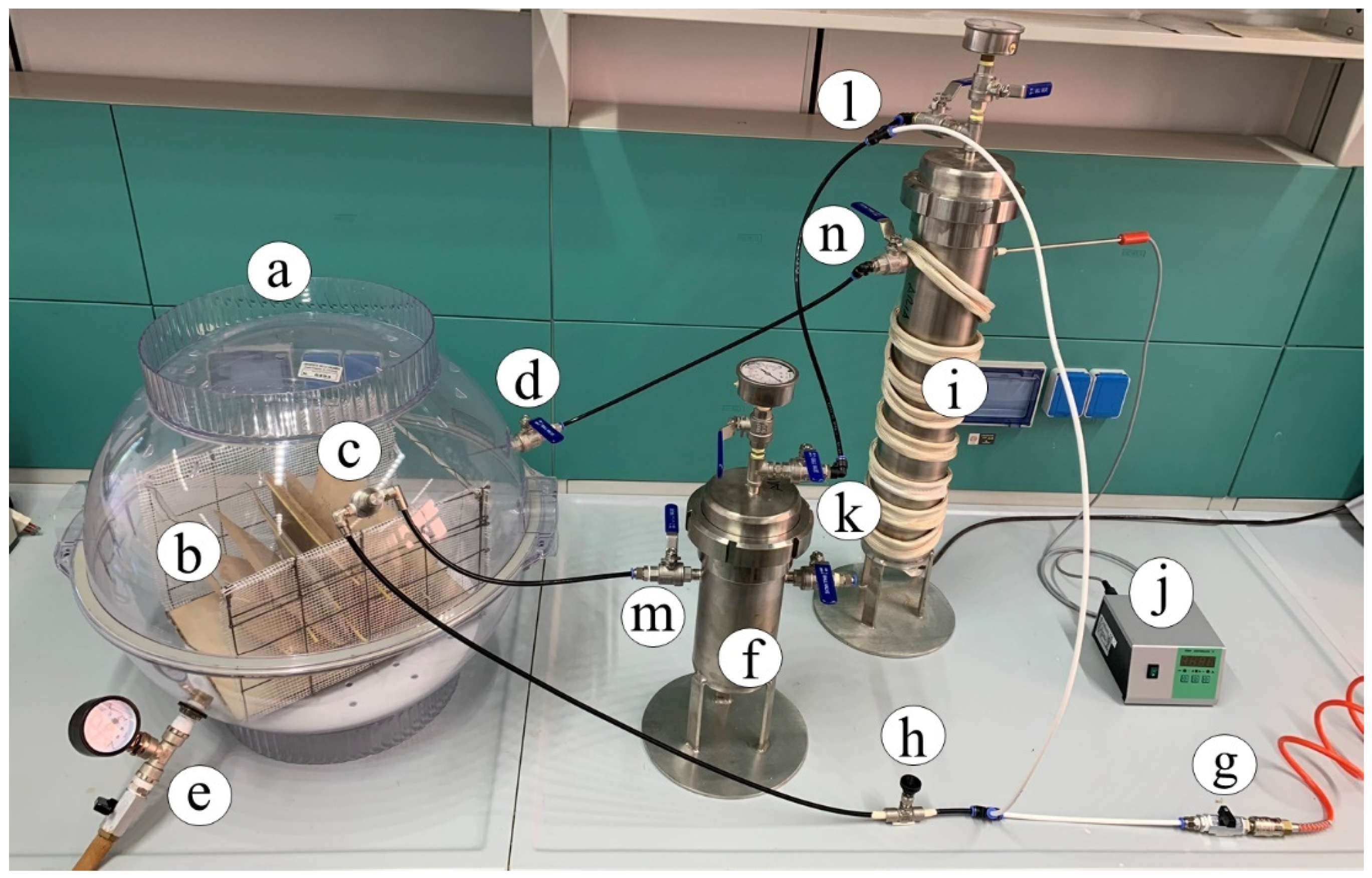
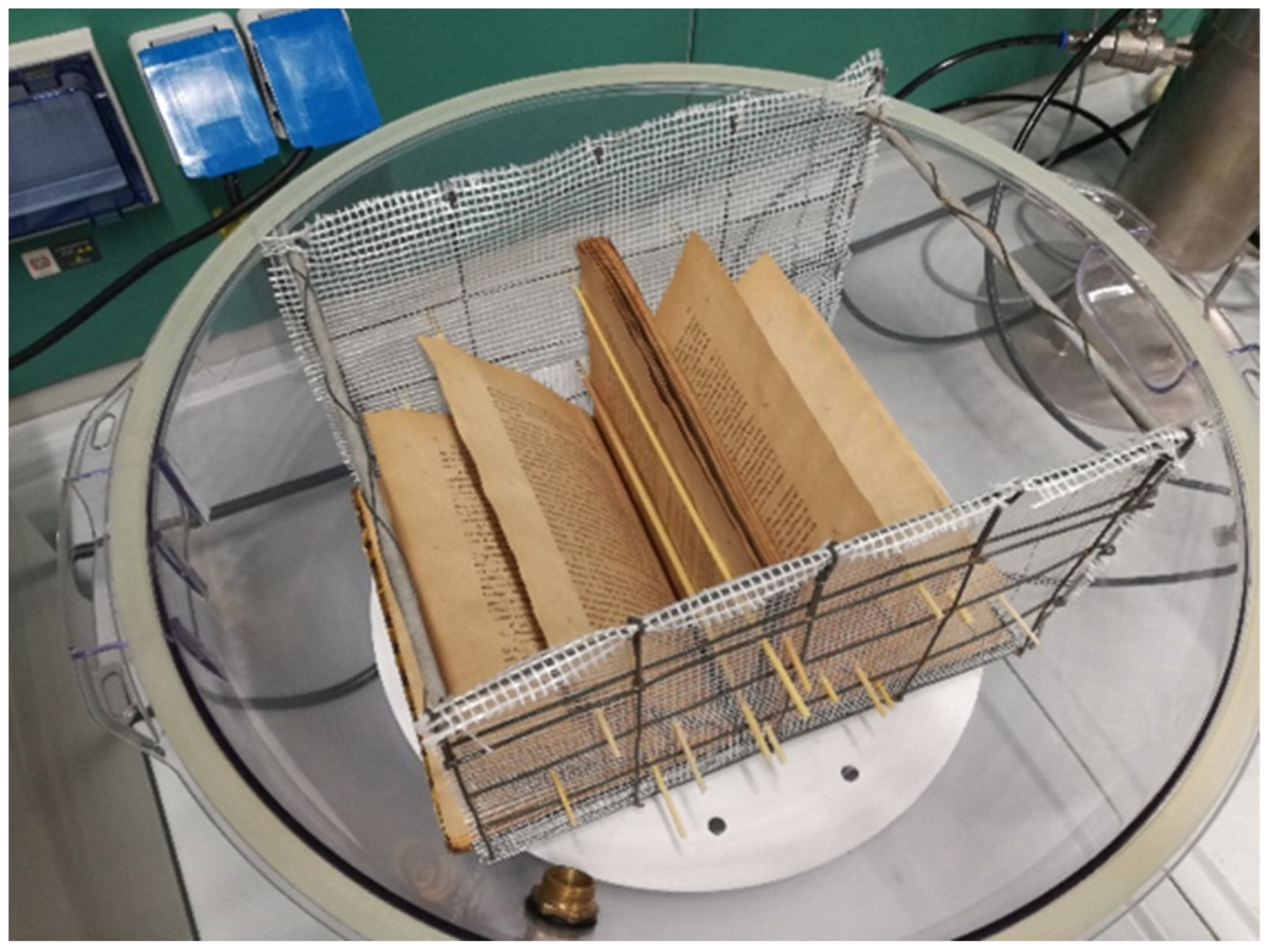
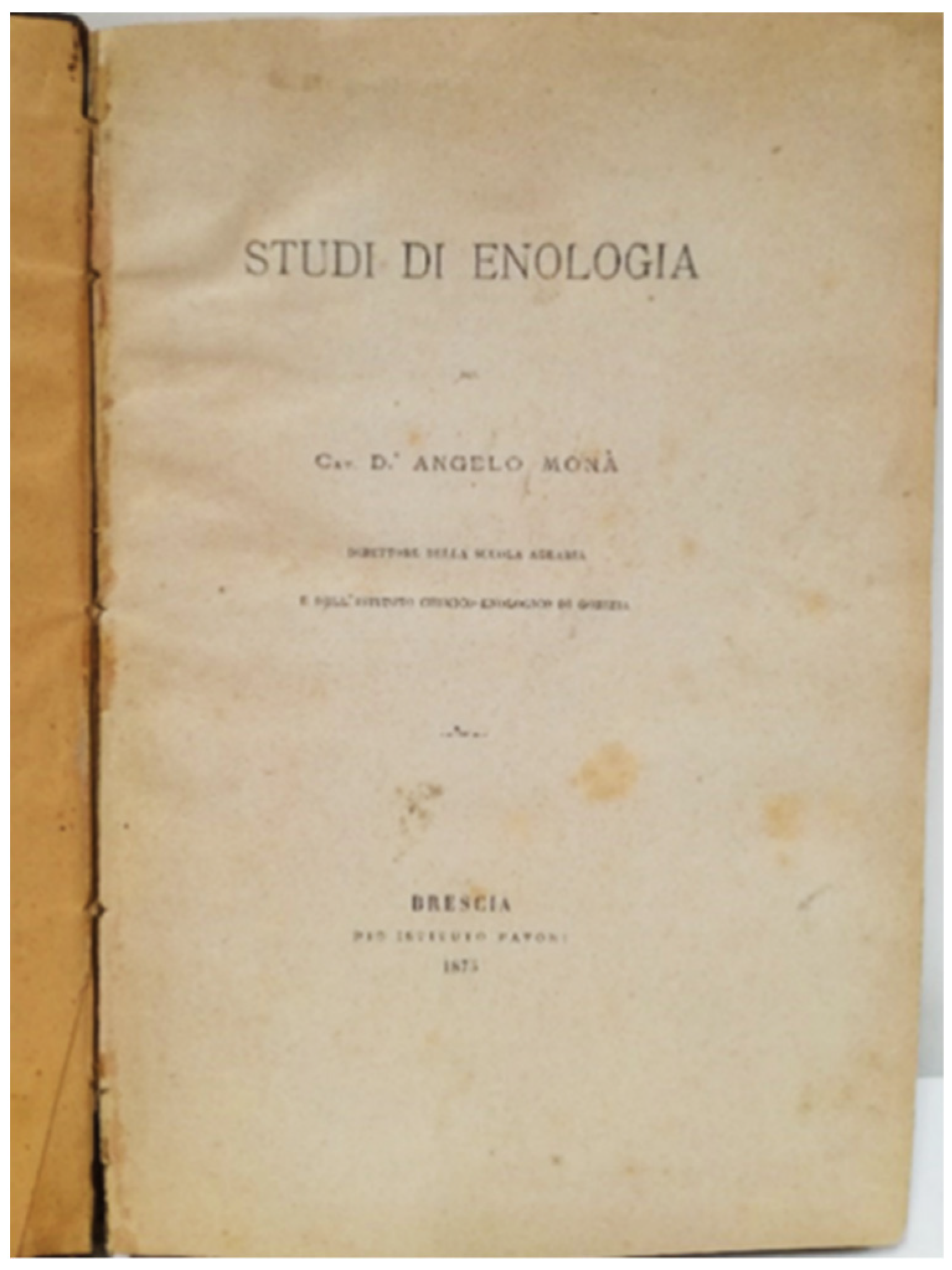
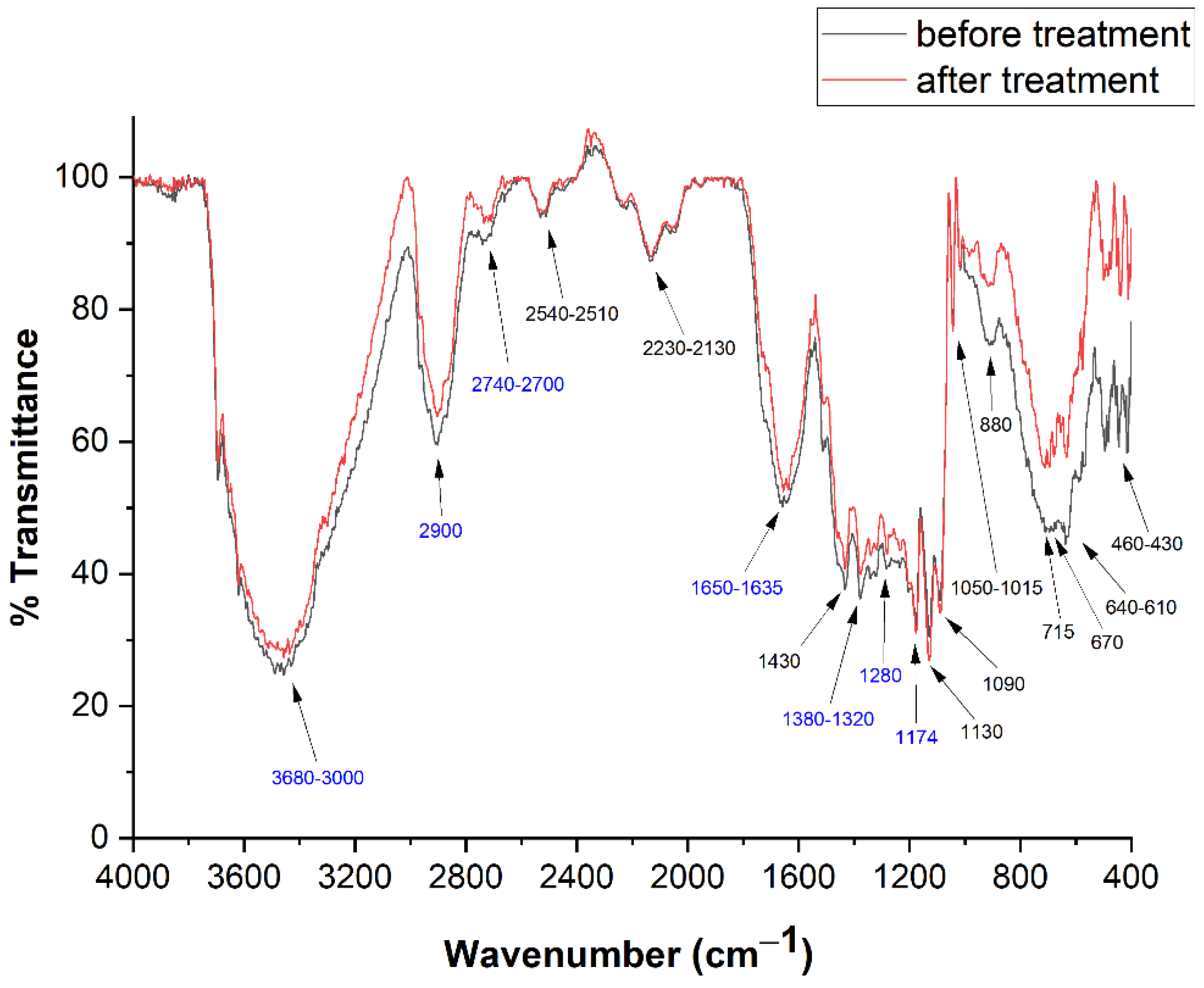

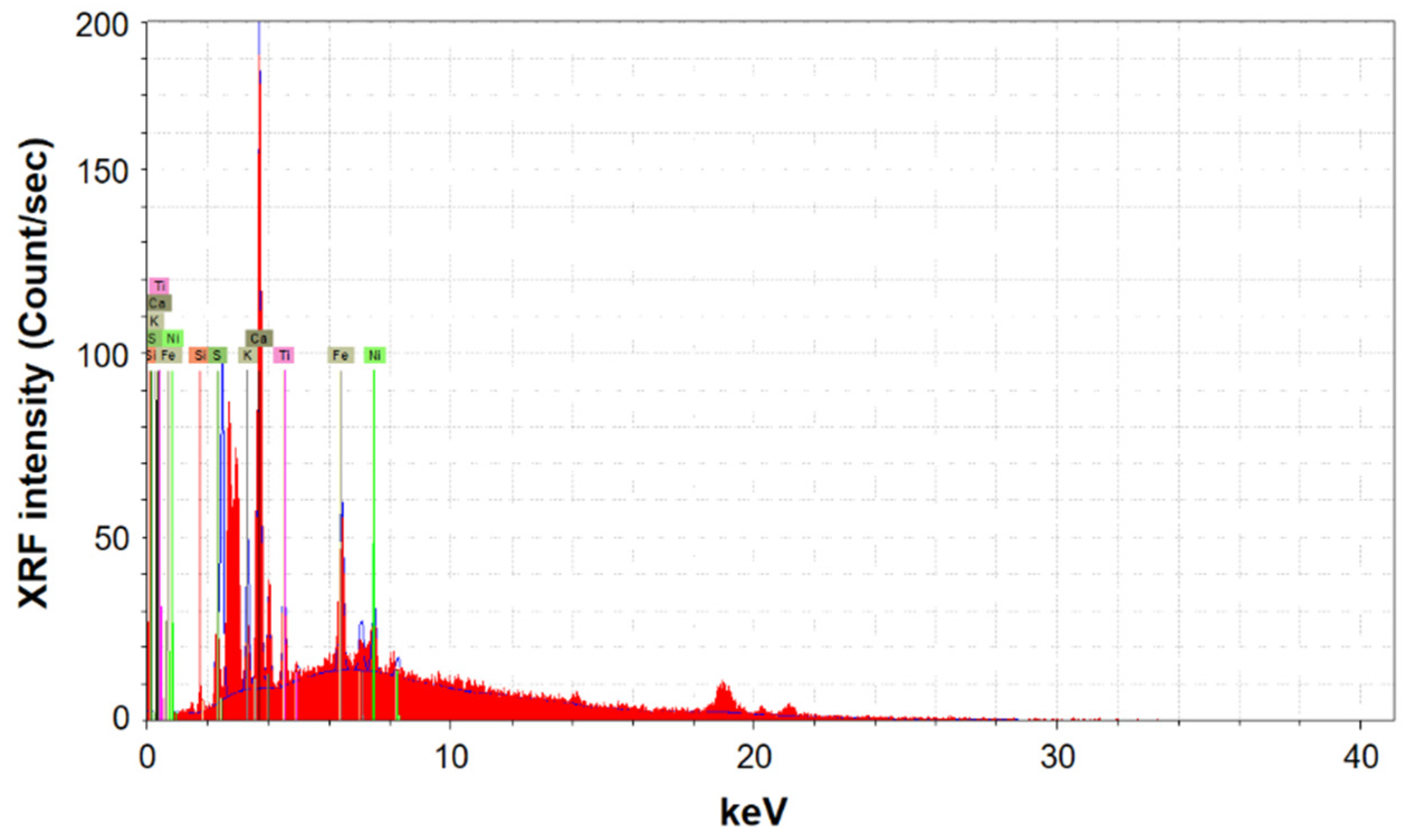
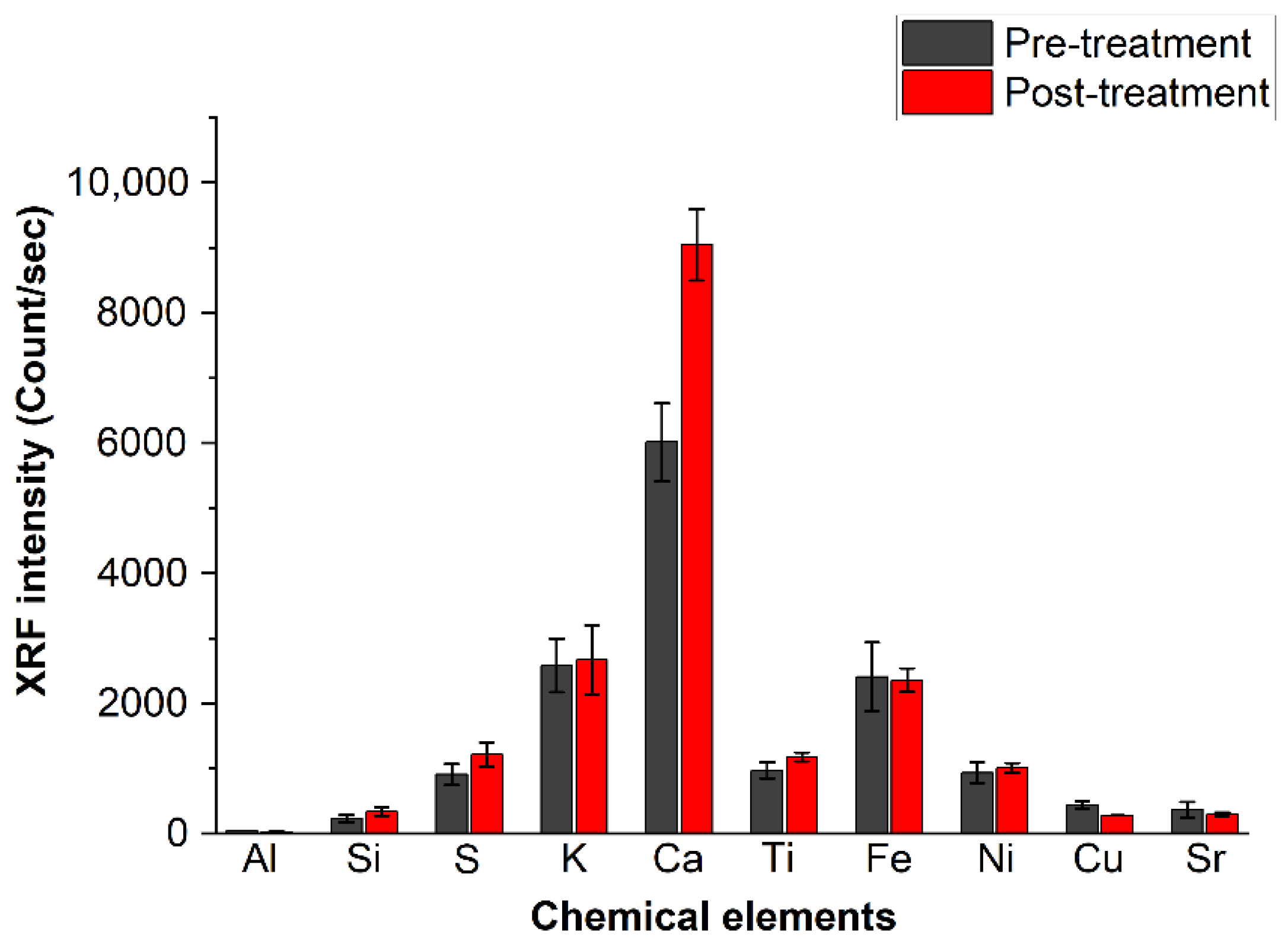
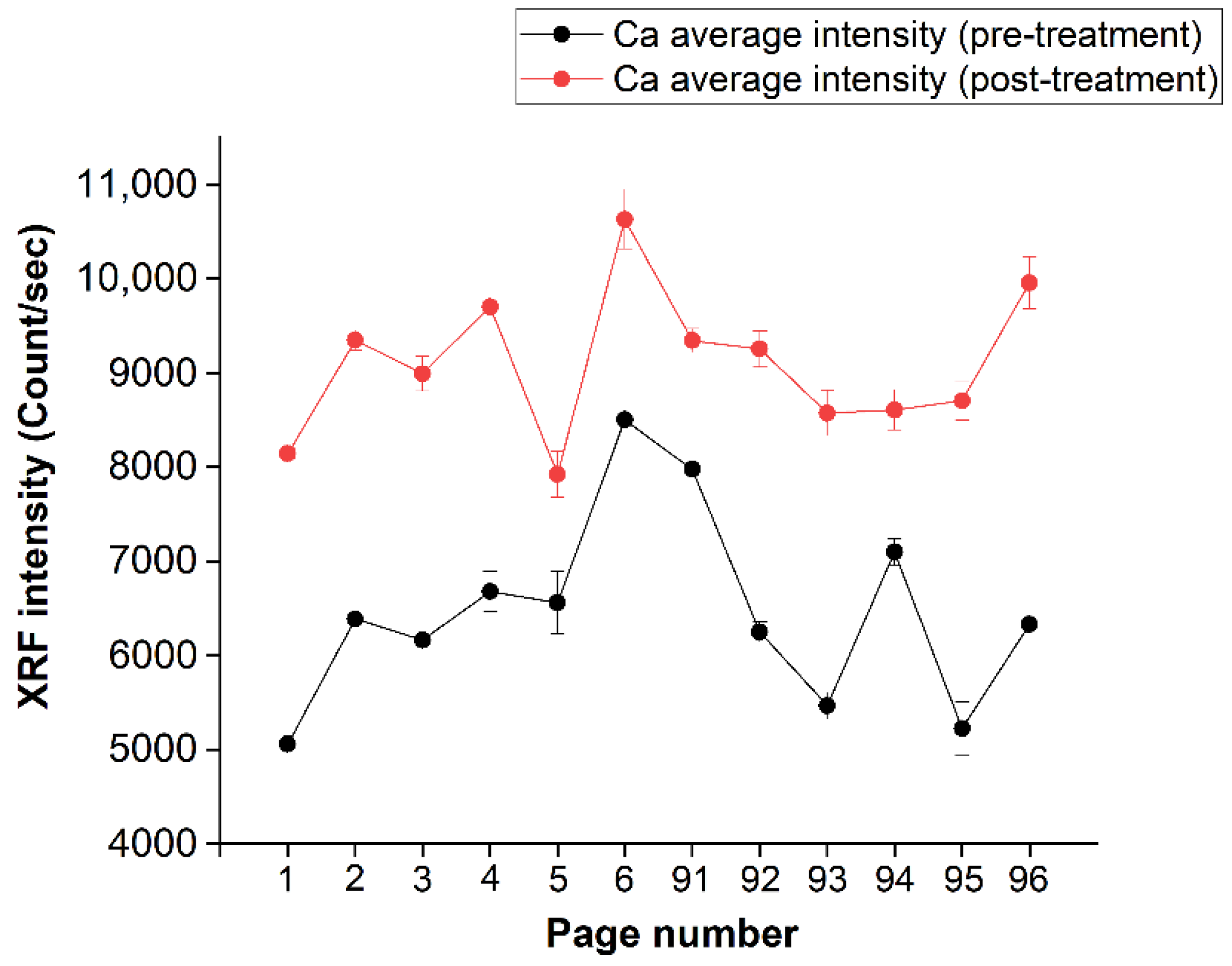

| Wavenumber (cm−1) | Functional Chemical Groups | Chemical Compound |
|---|---|---|
| 3680–3000 | OH stretching | Cellulose |
| 2900 | CH stretching | Cellulose |
| 2740–2700 | CH stretching | Cellulose |
| 2540–2510 | CO stretching | CaCO3 |
| 2230–2130 | CO stretching | CaCO3 |
| 1735 | C=O stretching | Cellulose |
| 1650–1635 | OH bending/adsorbed water | Cellulose and others |
| 1430 | CO stretching | CaCO3 |
| 1372 | CH bending | Cellulose |
| 1340 | CH bending | Cellulose |
| 1320 | CH bending | Cellulose |
| 1280 | CH2 twisting | Cellulose |
| 1174 | C-C stretching | Cellulose (and others) |
| 1130 | SO stretching asym | Ca(SO4)·2H2O |
| 1090 | CO stretching asym | CaCO3 |
| 1050–1015 | SO stretching | Ca(SO4)·2H2O |
| 870–880 | CO stretching asym | CaCO3 |
| 715 | CO stretching asym | CaCO3 |
| 670 | Ca-OH bending | Ca(SO4)·2H2O |
| 640–610 | Ca-OH bending | CaCO3 |
| 460–430 | Ca-OH stretching | CaCO3 |
| PXRD Identified Compound | Common Name | 2θ (°) | N.° Ref. |
|---|---|---|---|
| KAl(SO4)2·12H2O | K-alum | 12.6; 17.9; 20.4; 31.2; 32.3; 34.7; 44.7 | R040134 |
| KAl3(SO4)2(OH)6 | Alunite | 17.9; 25.7; 29.6; 39.4; 47.8 | R060430 |
| FeO(OH) | Goethite | 21.0; 33.6; 34.7; 36.8 | R050142 |
| Ca4Al6O12(SO4) | Ye’elimite | 23.5; 33.6; 36.3; 50.5; 56.6; 58.4; 60.5; 62.4 | COD 9009938 |
| TiO2 | Anatase | 25.1; 37.7; 47.8 | R060277 |
| CaCO3 | Calcite | 29.6; 39.4; 48.5 | R040070 |
| NiO | Bunsenite | 37.7; 43.5; 63.5; 75.5 | R080121 |
| Colorimetric | Pages Average | SD Pages | Ink Average | SD Ink | |
|---|---|---|---|---|---|
| Coordinate | Value | Value | |||
| (a) Untreated | L* | 70.4 | 0.5 | 51.0 | 1.0 |
| a* | −14.2 | 0.2 | 3.6 | 1.0 | |
| b* | 16.2 | 0.2 | 16.0 | 0.5 | |
| W | 71.8 | 0.7 | 45.3 | 1.2 | |
| (b) Deacidified | L* | 69.8 | 0.7 | 50.7 | 0.8 |
| a* | −15.4 | 0.3 | 3.0 | 0.4 | |
| b* | 16.6 | 0.3 | 16.6 | 0.6 | |
| W | 71.5 | 1.1 | 45.1 | 1.1 | |
| Variation between b and a (deacidified − untreated) | ΔL* | −0.6 | 1.2 | −0.3 | 1.8 |
| Δa* | −1.2 | 0.6 | −0.6 | 1.4 | |
| Δb* | 0.4 | 0.5 | 0.6 | 1.1 | |
| ΔW | −0.3 | 1.8 | −0.2 | 2.3 | |
| ΔE* | 1.4 | 0.9 | 0.9 | 2.2 | |
| (c) Untreated and aged | L* | 62.5 | 0.2 | 61.7 | 0.7 |
| a* | −21.3 | 0.3 | −18.4 | 1.5 | |
| b* | 20.8 | 0.1 | 18.5 | 0.8 | |
| W | 64.2 | 0.5 | 61.4 | 1.7 | |
| Variation between c and a (Untreated and aged − untreated) | ΔL* | −7.9 | 0.7 | 9.8 | 1.8 |
| Δa* | −7.1 | 0.5 | −21.9 | 2.5 | |
| Δb* | 4.5 | 0.2 | 2.5 | 1.4 | |
| ΔW | −7.3 | 1.2 | 16.1 | 2.9 | |
| ΔE* | 11.5 | 1.0 | 24.1 | 2.6 | |
| (d) Deacidified and aged | L* | 67.8 | 0.2 | 52.9 | 0.5 |
| a* | −18.3 | 0.4 | 2.7 | 0.2 | |
| b* | 17.5 | 0.3 | 18.1 | 0.5 | |
| W | 70.1 | 0.6 | 47.7 | 0.7 | |
| Variation between d and a (deacidified and aged − untreated) | ΔL* | −2.6 | 0.7 | 1.9 | 1.5 |
| Δa* | −2.9 | 0.7 | −0.9 | 1.2 | |
| Δb* | 1.3 | 0.5 | 2.1 | 1.1 | |
| ΔW | −1.7 | 1.2 | 2.4 | 1.9 | |
| ΔE* | 4.1 | 1.0 | 2.6 | 2.0 |
| Sample | DP |
|---|---|
| (a) Untreated | 825 ± 31 |
| (b) Untreated and aged | 369 ± 26 |
| ΔDP = A − B | 456 ± 57 |
| Depolymerization (%) | 55 |
| (c) Deacidified | 700 ± 37 |
| ΔDP = A − C | 125 ± 68 |
| Depolymerization (%) | 15 |
| (d) Deacidified and aged | 568 ± 20 |
| ΔDP = A − D | 257 ± 51 |
| Depolymerization (%) | 31 |
Publisher’s Note: MDPI stays neutral with regard to jurisdictional claims in published maps and institutional affiliations. |
© 2021 by the authors. Licensee MDPI, Basel, Switzerland. This article is an open access article distributed under the terms and conditions of the Creative Commons Attribution (CC BY) license (https://creativecommons.org/licenses/by/4.0/).
Share and Cite
Chidichimo, G.; Crispini, A.; Tursi, A.; Basile, M.R.; Lania, I.; De Filpo, G.; Rossi, C.O.; Scarpelli, F. Water-Based Aerosol for Book Deacidification: Experimental Apparatus and Theoretical Interpretation of Results. Molecules 2021, 26, 4249. https://doi.org/10.3390/molecules26144249
Chidichimo G, Crispini A, Tursi A, Basile MR, Lania I, De Filpo G, Rossi CO, Scarpelli F. Water-Based Aerosol for Book Deacidification: Experimental Apparatus and Theoretical Interpretation of Results. Molecules. 2021; 26(14):4249. https://doi.org/10.3390/molecules26144249
Chicago/Turabian StyleChidichimo, Giuseppe, Alessandra Crispini, Antonio Tursi, Maria Rita Basile, Ilaria Lania, Giovanni De Filpo, Cesare Oliviero Rossi, and Francesca Scarpelli. 2021. "Water-Based Aerosol for Book Deacidification: Experimental Apparatus and Theoretical Interpretation of Results" Molecules 26, no. 14: 4249. https://doi.org/10.3390/molecules26144249
APA StyleChidichimo, G., Crispini, A., Tursi, A., Basile, M. R., Lania, I., De Filpo, G., Rossi, C. O., & Scarpelli, F. (2021). Water-Based Aerosol for Book Deacidification: Experimental Apparatus and Theoretical Interpretation of Results. Molecules, 26(14), 4249. https://doi.org/10.3390/molecules26144249









